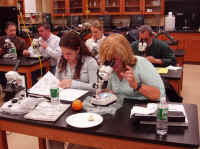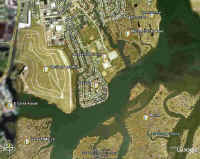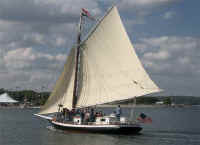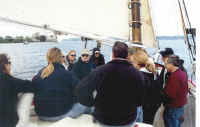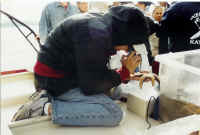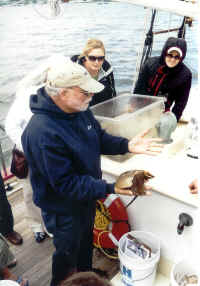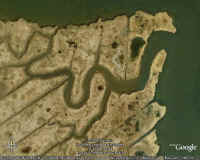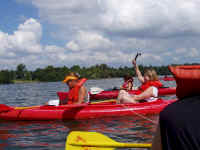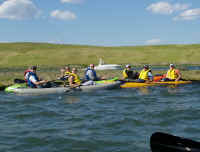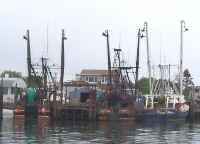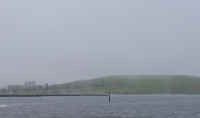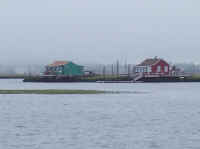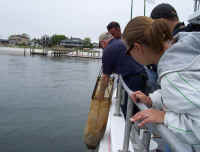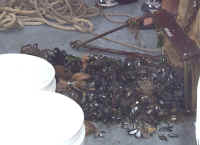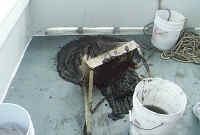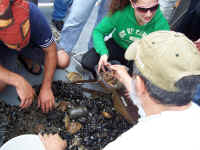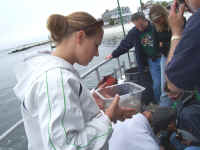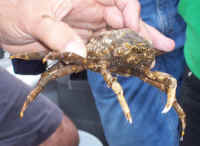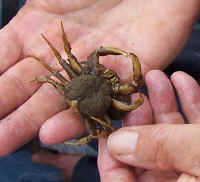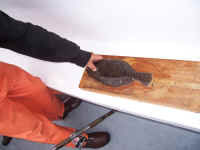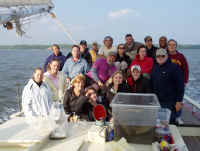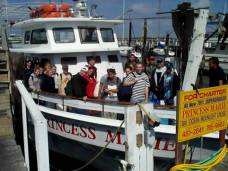
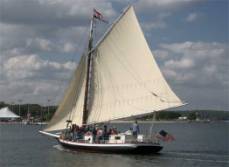
Shipboard
supported by
The
Environmental Protection Agency
The New York State Marine Education Association
South
Shore Estuary Reserve Office
Oceanside Teacherís Center
Dowling College
Lou Siegel Ed Wilensky
Click on images to enlarge
At each session a discussion of a particular parameter was followed up by a laboratory period during
which participants familiarized themselves with the appropriate equipment
Getting the feel for accurate wind measurements in the lab
Practicing titration of oxygen for this important parameter.
Dissecting and compound microscopes were used to examine plankton samples in several biological keys.
Our first field trip was to the Town
of Hempstead,
Marine Study Area in Oceanside. Participants
discussed
planning and development options
at this "natural" area nestled
between a former
landfill, housing, an organized recreational park
facility and a golf course. We examined the plant
populations and
zonation of the marsh and upland
populations which are largely delineated
by the
exposure to salt water due to changing elevations.
Each of the abiotic factors studied
in lab was then
measured in the field. Here Ed Wilensky is
demonstrating the use of a hydrometer to
measure salinity and density.
Our first shipboard experience was on
the historic
oyster fishing sloop, Christeen, at the Oyster Bay
Waterfront Center. Here we reviewed the basics
of this traditional way of boating, sampled the
biological specimens with a dredge and plankton
net and measured the abiotic parameters. It was
a great day out on the water on this excellent
platform for environmental education!
Participants learned how to raise the sails and steer the vessel into safe waters
A wide variety of organisms were
caught in the
bottom dredge including several horseshoe crabs,
hermit crabs, mussels, clams, and seastars.
Several specimens were held in a fish tank for
closer examination by the participants. The life
histories and classification of each were
reviewed. Lou Siegel demonstrated how to milk
eggs and sperm from the horseshoe crabs.
The close up exploration of the
marshes of the South Shore Estuary Reserve by kayak included a paddle
up a sinuous
channel. We were also able to observe historic ditching done to
drain the uplands
of mosquito breeding ponds. Abiotic and biotic
readings were again taken.
The closed Oceanside sanitary landfill is
in the background.
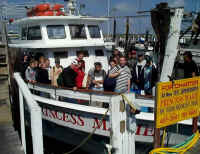
Use of underutilized
recreational fishing boats by schools and organized groups to explore the
estuarine environment is a win for everyone. The final trip of the class was on the fishing boat,
Princess Marie out of Point Lookout. Stations are selected to demonstrate the variety of
environments within the bay.
Here we get a good look
at the commercial fishing
fleet at Point Lookout.
As we travel
from one site to another there is the opportunity to discuss issues
related to landfills and
electricity generation plants. A close
examination of the picture below will reveal a mist over the water
which
is flowing from the outfall of the electric plant at left. The cooling
water is returned to the bay at an
elevated temperature. The
Hempstead Bays also host some of the last remaining bay houses
which
are on long term lease from the town.
At each station
we measure the abiotic parameters at the surface and bottom, then the
biological parameters
are sampled using the plankton and bottom dredge
nets. Below we can see the difference between the bottom
sample at the station near to Jones Inlet where there is a high level of
water exchange and that at the back bay
station where water flow is
restricted in the artificially deep, dredged channel.
The dredge is towed behind the boat
for several
minutes at the selected site. Here the net is
retrieved
from the stern of the boat.
Diverse bottom dredge sample from Jones Inlet.
Black, anaerobic, mayonnaise like mud at back bay station.
Participants sort through the dredge sample.
After all of the data is collected it is time to sample the ichthyological community by offering them some food, on a hook at the end of a long stick. Everyone loves fishing!
The date, location, size and
type of fish caught is
recorded. A few scales are collected and
placed
into an envelope with the information. During a
later lab session the scales
are examined and
drawn by the students.
One special session was held for boat captains at
the Freeport
Maritime Center. Here we see a
representative of Nassau BOCES
discussing the
various types of trips which they offer and reviewing
the
boat requirements for a successful contract.
The class on the historic Christeen oyster sloop at the Waterfront Center in Oyster Bay
Back to www.NYSMEA.org
For further information about the
program
contact: Lou Siegel
